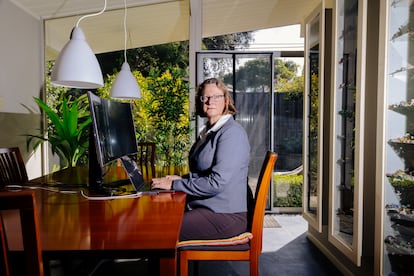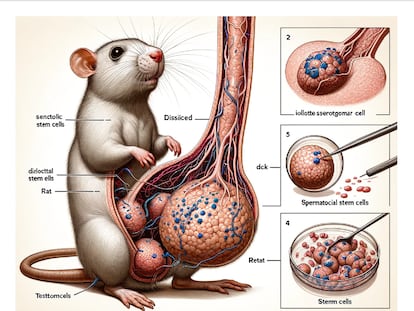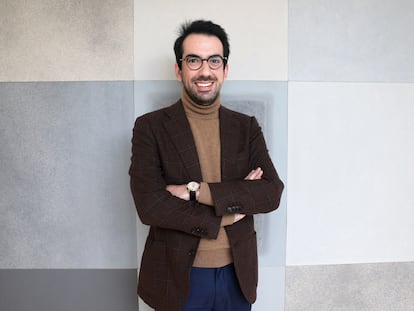Elisabeth Bik, expert in scientific integrity: ‘We need to slow down scientific publishing’
The Dutch microbiologist has been voluntarily searching for duplicate, erroneous or retouched academic images for more than 10 years and warning universities and scientific journals about it

Elisabeth Bik, 57, does the work of a detective. She spends hours reading and rereading documents, delving into pages, making notes, asking questions and solving cases. But her cases have nothing to do with murders, scams, robberies, infidelities or state secrets, but rather science. A microbiologist by profession, she has been a scientific integrity consultant since 2019 and has revealed academic errors in thousands of scientific articles. Her analyses focus on images that accompany a research paper that may have been retouched or duplicated by the authors, either by mistake or for fraudulent purposes. Bik, who speaks to EL PAÍS by video call, believes that the publication of scientific articles has become an unstoppable and accelerated wheel and that it must be slowed down to prevent a rise in falsehoods and manipulations.
Question. What led you to your interest in fraud in scientific literature?
Answer. One day I read about plagiarism, I took a sentence from an article I had written and put it in quotes in Google Scholar. The result was not only my own paper, but there were two other hits: one was in another article and the other was in a book chapter. The authors, who were from Italy, had taken two of my paragraphs and also paragraphs from other authors and built a new article by stealing a paragraph here and a paragraph there. That made me very angry, so I started searching for more examples of plagiarism. It was like a hairball, you find one thing and you start pulling and you find more.
Q. And the manipulated images?
A. By accident, I found in a PhD thesis not only plagiarized text, but also duplicated images. There were three photos and they were all the same, but one was mirrored, it was a mirror image but recognizable. I thought, I’ve seen this before. Then I switched from looking for plagiarized articles to looking for image duplication because it’s faster. Plagiarism took time, you have to put each sentence in Google Scholar and it was very slow.
Q. How many articles have you analyzed?
A. I searched 20,000 papers and found around 800 of them to contain these duplications. By now, about half of them have been corrected or retracted. I reported them in 2015, nine years ago, although I did not report them all at once. After five years, about 30% had been corrected or retracted and now it is about 50%. Many of these articles are still being corrected or retracted.
It’s not always clear whether problems in images are fraud or an honest error
Q. Do you consider this a high or low number of corrections?
A. Now it is approximately half, but the fact that before most of these articles had not been acted up was very surprising and a disturbingly low [correction] number. I was frustrated by the lack of responses from the journals. These numbers are still going up because I’m sending reminders and calling them out on Twitter: “Hey, this paper I reported in 2015, you still haven’t done anything.”
Q. What do you think the reason for this is?
A. There could be a multitude of reasons. Sometimes an editor, especially if it’s from a smaller journal, might have never had to deal with suspicions of misconduct or a correction. And they just don’t know what to do. They might contact the author, but maybe that person moved to another university or they have a very common name and they are not sure if the person is the same person who wrote the paper 10 years ago. Or the author may send a reply and say, “Oh yeah, sorry, here are some new images.” And then the editor thinks: “Well, case closed.” But they don’t really address it. They feel that the case has been closed, but they don’t report it to me, for example.
Q. What is considered a fraudulent scientific image?
A. It is not always clear if problems in images are fraudulent or an honest error. I have three categories of duplications that I look at. One is when the exact same photo has been used to represent figure one and figure three. It’s the same photo, but they are representing different experiments. That could be an honest error, somebody grabs the wrong photo. The second is whether the images overlap or are rotated or shifted or stretched. It’s a little more likely that that was done on purpose, with the intent to mislead, especially when it’s a rotated photo. That usually doesn’t happen by accident. And the third type is when within a photo you see duplicated bands or cells or tissues. That is done intentionally, the cells don’t use Photoshop.

Q. Why does someone duplicate the image of a cell with Photoshop?
A. Sometimes it is to hide a crack or a hair or some dust on the lens. But it could also be intentionally to make it look like there are more cells or fewer cells. So they copy the background over some cells, for example. You never [fully] know why it was done or if it was fraud. We may have an idea if something was done intentionally, but there could be an innocent reason behind it. For me, it’s hard to know. Some cases are very obvious that it was misconduct, but in most, you’re not quite sure.
Q. What happens next?
A. The editor needs to ask the author and the author needs to produce the original photos. I’ve seen cases where the author says there was a crack in a corner and they patched it up with some background tissues. In most cases, only the institution can do an investigation. They need to investigate the author or the research group and they need to compare the lab books to what has been published. That can obviously take a long time. That’s another reason why these papers aren’t retracted. In some cases, the institution claims to be investigating, but they don’t really want to investigate because it’s their star professor.
Q. How do you know if an article may contain these types of images?
A. I get tips from people, but I’m still working off my initial research of 20,000 articles. I found 800 papers with problems, I can follow leads. For example, I found a problem in such and such an article, I can look at other articles by the same authors and see if there is a problem associated with a particular person, moving from one lab to another, or if it is a problem in that lab where maybe there’s sloppiness or a culture of misconduct. I follow all these leads and I get a daily stream of people saying, can you look at this paper?
In some cases, the institution claims to be investigating, but they really don’t want to investigate because it is their star professor
Q. What is the process for identifying manipulated images?
A. I download the article or look at it online. I look at figures that are photos, or a bar graph or a line graph or something similar. I look for things like missing error bars or weird bars or axes numbering that doesn’t make sense, or repetitive features on a spectrum. I scan by eye, but I also use software: ImageTwin and Proofic. The first one has a lot of false positives, because a lot of photos look similar, and you have to work through them and de-click them. But it has a database of photos from other papers that are open access and compares all the photos in a particular article against that big database. It’s like a Google image search, but focused on scientific papers.
Q. On more than one occasion you have mentioned that your inquiries, especially at the beginning, were not always taken seriously.
A. In the beginning, many people did not believe what I was finding. They thought it was something only I saw. Imagine you’ve written a bunch of articles and someone comes back and says, “some of the articles you wrote five years ago contain a typo and I want that to be corrected.” You think, “Who cares?” They just didn’t pay attention. Even my collaborators didn’t believe me at first either. After we published the article where we showed that this happens, that you can find errors in one in every 25 articles, they saw that it was a real problem and took us a little more seriously. I have gained credit that I don’t make wrong accusations, but it takes time.
Q. Years later, you continue to encounter resistance and not very positive reactions from the scientific community.
A. No one likes to be criticized for the work they produce. If someone finds and points out an error in your work, you may feel annoyed, angry and defensive. They say things like, “Yes, but I wasn’t feeling well,” or “we just moved labs and made some mistakes.” They try to find excuses or claim that it was someone else’s fault. Most of them become a little defensive, but some are even aggressive and start attacking me, digging into my past, they find out where I live, who my family is. Then they lash out on Twitter or write weird articles about me, about how I’m an evil person. But there is no evidence that I was wrong. For now I have not been sued, they’re just threats. I’ve been extremely lucky, but at some point I’ll run out of luck.
Q. Has the use of manipulated images increased, decreased or stayed the same in recent years?
A. It has increased and it has also decreased. It grew from 2010 to 2018-2019 and is now declining because people simply do a better Photoshop job and they know that we can screen for these things. There are many ways to cheat that leave no trace and are becoming harder to see because the fraudsters are getting smarter. Also because of the rise in the [use] of artificial intelligence. Now we can create images that are completely unique and fairly realistic that, with my techniques and software, I cannot detect as a problem.
Q. Are you worried about artificial intelligence?
A. Very much. It’s true that it can be used to do good things, obviously, but it can also be used by the fraudsters to create fake images, fake data, fake text. I’m not completely worried about fake text; scientific data fraud worries me more than text generation. You can ask it to generate a fake set of patients, split them into two groups and do some experiment with them. It is so good that we can no longer distinguish those sets from real data sets. We’re only going to catch the really dumb fraudsters because they leave traces for us to find. There are smart fraudsters who will be very thankful for AI that can help them generate even more fake papers.
Q. Do you think part of the problem has to do with how quickly scientific publications are supposed to be produced?
A. Definitely. We focus on metrics to evaluate a scientist’s career: how many articles they have published, how many times they were cited, what was the impact factor of all these articles. These are numbers you can look at and it’s easy to rank your candidates according to these metrics. People are going to try to fake these metrics, they’re going to cite themselves a lot, or they’re going to buy a paper from a paper mill or slice their papers into little pieces and publish all of them. There are universities that have strict requirements. For example, if you want to get your PhD, you need to publish two or three papers before you can get it. That’s not completely fair, because you can be a brilliant scientist, but the experiments might not work and you may not have published any papers.
Q. How do you think scientific journals are responding to the detection and prevention of image manipulation?
A. Now they are realizing it, but I think it’s too late. They have not been very vigilant in finding these problems, especially for paper mills. It’s not just individual labs that are cheating, it’s a criminal organization that is pumping out paper after paper. And those have not been picked up by journals, they’ve been picked up by volunteers. We’ve been alerting the journals that they need to set safeguards a little higher and not let this crap go through. After they are published, it’s very obvious that it’s fake.
Journals are starting to set up safeguards like image duplication detection by screening for ChatGPT-generated language, and in the meantime, fraudsters know we’re going to screen for these things. It’s a rat race where the fraudsters will always win, but we can make it harder for them. We need to slow down scientific publishing.
Sign up for our weekly newsletter to get more English-language news coverage from EL PAÍS USA Edition
Tu suscripción se está usando en otro dispositivo
¿Quieres añadir otro usuario a tu suscripción?
Si continúas leyendo en este dispositivo, no se podrá leer en el otro.
FlechaTu suscripción se está usando en otro dispositivo y solo puedes acceder a EL PAÍS desde un dispositivo a la vez.
Si quieres compartir tu cuenta, cambia tu suscripción a la modalidad Premium, así podrás añadir otro usuario. Cada uno accederá con su propia cuenta de email, lo que os permitirá personalizar vuestra experiencia en EL PAÍS.
¿Tienes una suscripción de empresa? Accede aquí para contratar más cuentas.
En el caso de no saber quién está usando tu cuenta, te recomendamos cambiar tu contraseña aquí.
Si decides continuar compartiendo tu cuenta, este mensaje se mostrará en tu dispositivo y en el de la otra persona que está usando tu cuenta de forma indefinida, afectando a tu experiencia de lectura. Puedes consultar aquí los términos y condiciones de la suscripción digital.
More information
Archived In
Últimas noticias
The complicated life of Francesca Albanese: A rising figure in Italy but barred from every bank by Trump’s sanctions
Half of Scotland is in the hands of 420 property owners
Pinochet’s victims grapple with José Antonio Kast’s rise in Chile
Reinhard Genzel, Nobel laureate in physics: ‘One-minute videos will never give you the truth’
Most viewed
- Pablo Escobar’s hippos: A serious environmental problem, 40 years on
- Why we lost the habit of sleeping in two segments and how that changed our sense of time
- Charles Dubouloz, mountaineering star, retires at 36 with a farewell tour inspired by Walter Bonatti
- Reinhard Genzel, Nobel laureate in physics: ‘One-minute videos will never give you the truth’
- The Florida Keys tourist paradise is besieged by immigration agents: ‘We’ve never seen anything like this’










































